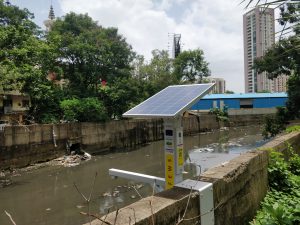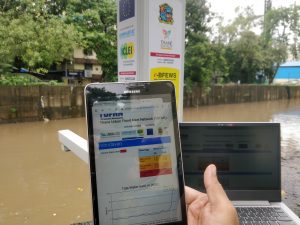TUFAN: Thane’s Pilot-Scale Flood Warning System Augments City’s Climate Resilience

Thane city has implemented an early warning system called the Thane Urban Flood Alert Network (TUFAN), to help better address incidence of waterlogging and flooding in the city through the Urban-LEDS II project. The real-time warning system comprises four ultrasonic water-level sensors, two radar-based water-level sensors and an automatic weather monitoring station. Real-time information captured by the sensors is shared through a webpage.
The city is advancing towards low-emission and climate-resilient development with the support of the Urban-LEDS II project, by preparing its greenhouse gas (GHG) inventory, conducting Climate Risk and Vulnerability Assessment, implementing pilot projects and formulating a Climate Action Plan.
The frequency of high-intensity rainfall in the Urban-LEDS II model city of Thane, located close to the Arabian Sea, is increasing. The city is susceptible to flooding and waterlogging, when high-intensity rainfall coincides with tidal variations that impact the water levels in the Ulhas River estuary and Thane Creek, the city’s main water bodies. Having completed the implementation of the IoT-based TUFAN system, the Thane Municipal Corporation (TMC) is now better equipped for improving its preparedness, reducing the response time of emergency services, and for safeguarding human health and assets during incidents of waterlogging and flooding.
A detailed technical study was conducted to assess feasibility and to identify key locations for deploying sensors to monitor real-time water levels. The study looked at the areas that experienced frequent waterlogging, the micro-catchment areas, runoff contribution, rainfall trend, tidal influence and interconnections among major water bodies such as the Ulhas River estuary, Thane Creek and stormwater drains (nallahs).
Based on the analysis, six strategic locations (Saket, Gaymukh, Hiranandani Estate, Thana College, Vrindavan Society and Mumbra) were identified for deployment of the sensors. In addition, an automatic weather station has been set up to record rainfall and other parameters for understanding rainfall intensity and runoff generation. Detailed hydrological modeling has been conducted for nallah no. 3 (west) from Kacharali Lake to Thane Creek on the basis of the rainfall intensity and catchment characteristics. Excess runoff from this nallah impacts a number of areas vulnerable to waterlogging (Vandana theatre, Kopari Subway and Ram Maruti Road, among others) in the core city and hence, warnings by the TUFAN system enable key TMC departments to take precautionary actions such as diverting traffic and disseminating information. The remaining five sensors track water levels on a real-time basis. When water levels at the five locations exceed threshold flood levels, the concerned officials are informed through the TUFAN system. All data is communicated through the IoT platform and analysed at the Integrated Command and Control Centre of TMC, using a model developed under this project.
The TUFAN system was tested successfully during the current monsoon season for real-time monitoring and forecasting. A training program will be conducted soon to help the TMC officials better understand the system and its operations, and to train them on using the sensor information for their planning and appropriate responses during flooding/waterlogging incidents. The TMC and Thane Smart City are further strengthening the warning mechanism to reach out to key officials and vulnerable groups through various means. TUFAN is a pioneering system in the region, in terms of real-time monitoring, economical forecasting and in providing comparatively accurate warnings at the city-level.
With the help of the Urban LEDS II project, Thane city has also initiated assessment of the carbon sequestration potential of its trees and mangroves. In this study, sample plots are being surveyed by a team of experts and the data will be used further to quantify existing as well as future carbon sinks of the city. This assessment will help the city to know the potential of trees and mangroves in terms of carbon sequestration in addition to other ecosystem services, and help to develop conservation strategies.
The city is also formulating its climate resilience action plan under the Urban-LEDS II project. The plan will be ready by October 2021 and will provide strategic guidance to the city administration, key stakeholders and citizens on moving towards ambitious climate goals and contribute to India’s NDC commitments under the Paris Agreement.




